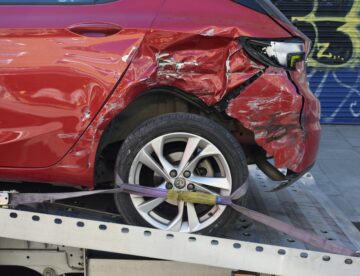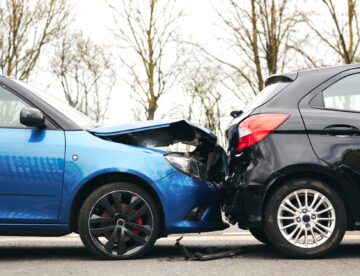
The Truth About a Minimal Damage Crash That Insurance Companies Don’t Want You to Know
If you’ve ever been in a “fender bender” where your car barely had a scratch but you felt hurt afterward, you’re not imagining things. Despite what insurance companies claim, new scientific research proves that real injuries happen in a minimal damage crash.
The Insurance Industry’s False Narrative
For over 30 years, insurance companies have used what they call the “minor impact” defense to deny legitimate injury claims. Their argument sounds reasonable on the surface: “If the car isn’t damaged, how can the person inside be hurt?”
Insurance defense experts often tell juries that the forces in a low-speed car crash are no different than everyday activities like sitting down in a chair, stepping off a curb, or even sneezing. This comparison has been used to convince people that their injuries must be fake or exaggerated.
The problem? This comparison is completely false.
Groundbreaking New Research Destroys the “No Damage, No Injury” Myth
A major scientific study published in 2021 examined this exact question: Are the forces in minimal damage car crashes really similar to normal daily activities?
The researchers found that “average peak linear and angular acceleration forces observed at the head during rear impact crash tests were typically at least several times greater than average forces observed during ADLs [activities of daily living].”
But here’s the most shocking finding: The injury risk of real-world minimal damage rear impact crashes was “at least 2000 times greater than for any ADL.”
Let that sink in. The risk of getting injured in a minimal damage car crash is 2,000 times higher than sitting in a chair or stepping off a curb.
Why Cars and Bodies React Differently in a Minimal Damage Crash
Think of it this way: Modern cars are engineered with crumple zones designed to absorb crash energy by bending and deforming. When a car doesn’t show damage, it means the vehicle absorbed the impact without crushing. But that energy has to go somewhere, and it transfers directly to the people inside.
As biomechanics research explains: “Cars absorb energy by crushing. Energy not absorbed by the car transfers to occupants.”
Your body operates completely differently than your car. While your vehicle might be designed to withstand an 8-15 mph impact without visible damage, your neck, back, and other soft tissues can be injured at much lower speeds. Studies document injuries occurring in crashes as low as 2.5 mph.
The Human Body Isn’t Built Like a Car Bumper
When you sit down in a chair, your muscles are prepared and your body controls the movement. In a car crash, even a minor one, the impact happens in milliseconds before your muscles can react. Research shows that “motions beyond physiological limits occurred within 75 milliseconds of impact, faster than reaction time for unwarned occupant to develop sufficient muscle force.”
Your neck forms an abnormal S-shaped curve during this critical window, which can damage delicate tissues that won’t show up on X-rays taken immediately after the crash.
Insurance Companies Know the Truth But Hide It
The insurance industry’s “minor impact” strategy wasn’t developed based on science. It was created in the 1990s as a business strategy to reduce claim payouts. Internal documents show that major insurers adopted this approach specifically to make injury claims so expensive to fight that people would simply give up.
The latest research concludes that defense experts’ biomechanical approach “invariably results in the vast underestimation of the actual risk of such crashes, and should be discontinued as it is a scientifically invalid practice.”
What This Means When Evaluating Expert Testimony Involving a Minimal Damage Crash
If you ever encounter a biomechanical expert claiming that minimal damage car crashes are no different than everyday activities, you now know this argument has been scientifically disproven. When experts make comparisons between car crashes and sitting in chairs or stepping off curbs, remember that peer-reviewed research found crash injury risk is 2,000 times higher than these daily activities.
Here are key questions the science raises about such testimony:
Is the expert using outdated research?
The foundational study supporting the “daily activities” comparison was published in 1994 using only 8 volunteers. Modern research with larger sample sizes and better methodology has definitively refuted these conclusions.
Is the expert ignoring energy transfer principles?
Basic physics shows that energy not absorbed by vehicle damage transfers to occupants. Any expert who dismisses this fundamental principle is not providing scientifically sound testimony.
Is the expert cherry-picking data?
Legitimate research consistently shows no correlation between vehicle damage and human injury potential. Experts who focus solely on property damage while ignoring biomechanical injury mechanisms are presenting an incomplete picture.
The scientific community has concluded that the biomechanical approach to injury causation “invariably results in the vast underestimation of the actual risk” and “should be discontinued as it is a scientifically invalid practice.”
When evaluating such expert testimony, remember that real injuries occur in a minimal damage crash because human tissue tolerance limits are fundamentally different from vehicle engineering specifications. The latest peer-reviewed research supports this conclusion unequivocally.
Injured in a minimal damage crash? Get a free case review from Burrow & Associates. Our attorneys know how to fight insurance company tactics and secure the compensation you deserve. Call now or contact us online to schedule your consultation.









